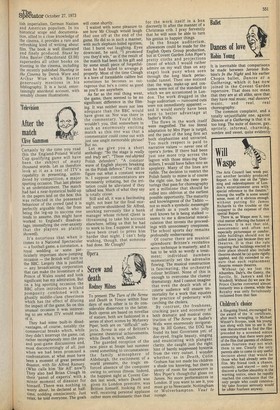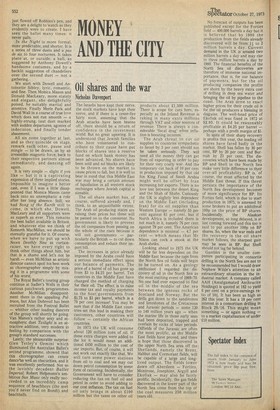Ballet
Dances of love,
Robin Young
It is inevitable that comparisons be made between Jerome Robbins's In the Night and his earlier Chopin ballet, Dances at a Gathering, which it has now joined in the Covent Garden repertoire. That does not mean that they are at all alike, save that they have real music, real dancers'
music, and real, real choreography.
The common complaint, and a totally unjustifiable one, against Dances at a Gathering is that it is too long. The suite of dances, gay, spritely, informal, charming, sombre and sweet, quite evidently just flowed off Robbins's pen, and they are a delight to 'watch as they evidently were to create. I. have seen the ballet many times: it never palls.
In the Night is more formal, more predictable, and shorter. It is a series of three duets and a pas de six to four nocturnes. It takes place at, or outside, a ball, as suggested by Anthony Dowell's handsome costumes, and by a backlit suggestion of chandeliers over the second duet — not a gathering.
We start with Dowell and Antoinette Sibley, lyric, romantic, and fine. Then Monica Mason and Donald MacLeary, more stately and elegant, she delightfully poised, he suitably martial and attentive. Finally Merle Park and David Wall in a course of true love which does not run smooth — a highly-strung, taut duet marked with sudden departures, agonies of indecision, and finally tender abasement.
All six come together at last, and as they coincide on stage, remark each other, pause and mingle — to be drawn, as by an irresistible magnetic force, back to their respective partners almost immediately, and dancing off again.
It is very simple — slight if you like — but it is a captivating expression of three implied stories. Impossible to imagine a better cast, even if I was a little disappointed that Monica Mason came back into so unemphatic a role after her long absence. Still, we had Song of the Earth still to come, in which she, Dowell, MacLeary and all supporters were as superb as ever. This remains the best ballet available in Britain, and whatever else we think of Kenneth MacMillan, we should be eternally grateful for it, Of course, when we have to put up with Seven Deathly Sins as curtainraiser, we have every right to think other things about him, but that is a shame and let's not be harsh — even McMillan as artistic director cannot spoil his best work as choreographer simply by mixing it in a programme with some of his worst.
The Royal Ballet's touring group continue at Sadler's Wells in their curious patchwork programmes. Another McMillan disappointment there in the appalling Poltroon, but Alan Dubreuil has been recruited from the Festival Ballet — whither other leading dancers of the group will shortly be going. Van Manen's rather sexy and atmospheric duet Twilight is an attractive addition, very modern in feeling by comparison with the group's standard successes.
Lastly, the pleasurable surprise: Glen Tetley's Gemini which illuminated. the Australian Ballet's second programme, showed that this choreographer can create, dance's well as obscurities, and it was excellently performed. Not so the lavishly decadent Ballet Imperial. Robert Helpmann's ambitious Sun Music only really succeeded in an incredibly camp sequence of beachboys (the sort you'd never find on Bondi) and beachballs.



































 Previous page
Previous page